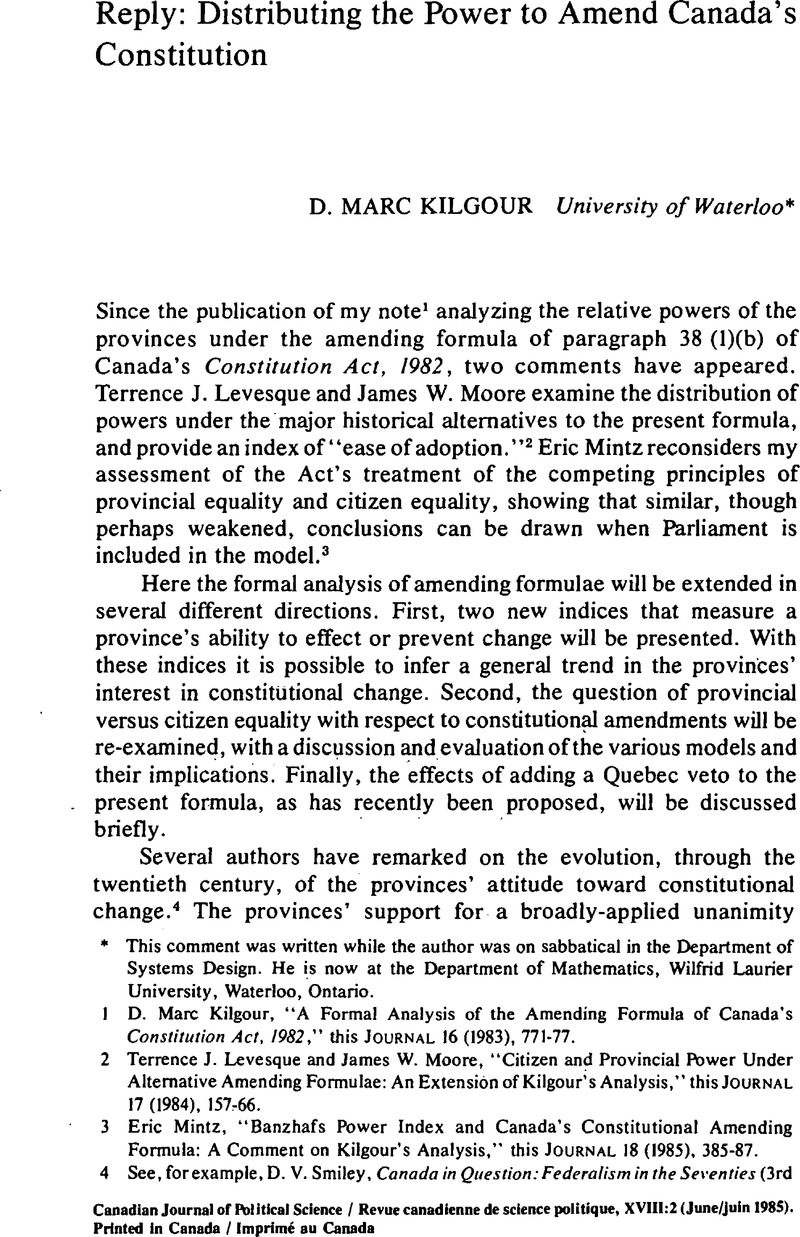Article contents
Reply: Distributing the Power to Amend Canada’s Constitution
Published online by Cambridge University Press: 10 November 2009
Abstract

- Type
- Comments/Commentaires
- Information
- Canadian Journal of Political Science/Revue canadienne de science politique , Volume 18 , Issue 2 , June 1985 , pp. 389 - 396
- Copyright
- Copyright © Canadian Political Science Association (l'Association canadienne de science politique) and/et la Société québécoise de science politique 1985
References
1 Kilgour, D. Marc, “A Formal Analysis of the Amending Formula of Canada's Constitution Act, 1982” this JOURNAL 16 (1983), 771–77.Google Scholar
2 Levesque, Terrence J. and Moore, James W., “Citizen and Provincial Power Under Alternative Amending Formulae: An Extension of Kilgour's Analysis,” this JOURNAL 17 (1984), 157–66.Google Scholar
3 Mintz, Eric, “Banzhafs Power Index and Canada's Constitutional Amending Formula: A Comment on Kilgour's Analysis,” this JOURNAL 18 (1985), 385–87.Google Scholar
4 See, for example, Smiley, D. V., Canada in Question: Federalism in the Seventies (3rd ed.; Toronto: McGraw-Hill Ryerson, 1980)Google Scholar and Kilgour, D. Marc and Levesque, Terrence J., “The Canadian Constitutional Amending Formula: Bargaining in the Past and the Future,” Public Choice 44 (1985), 457–80.CrossRefGoogle Scholar
5 The satisfaction index was first formalized by Straffin, Phillip J., Jr. in “Homogeneity, Independence, and Power Indices,” Public Choice 30 (1977), 107–17CrossRefGoogle Scholar, and in “Probability Models for Power Indices” in Ordeshook, Peter C. (ed.), Game Theory and Political Science (New York: New York University Press, 1978), 477–510. A related approach appears in Steven J. Brams and M. Lake, “Power and Satisfaction in a Representative Democracy,” in Peter C. Ordeshook (ed.), Game Theory and Political Science, 529–62. See also Kilgour and Levesque, “The Canadian Constitutional Amending Formula.”Google Scholar
6 A priori probability means that all possible combinations of the provinces' positions, pro or con, are assumed equally probable.
7 The usual satisfaction index is in fact the mean (average) of the positively and negatively oriented indices. Using the results of Straffin ("Homogeneity, Independence, and Power Indices"), it can be shown that the sum of the two oriented indices must exceed I by an amount equal to the value of the absolute (that is, not normalized) Banzhaf index. Also, the difference between the positively and negatively oriented index values must be the same for each province, under a given formula.
8 The formulae in Tables 1 and 2 are precisely those compared by Levesque and Moore ("Citizen and Provincial Power Under Alternative Amending Formulae"), and are applied using 1981 Census data (Statistics Canada, 1982) where appropriate. Detailed requirements for each formula are summarized by Levesque and Moore (158).
9 “Banzhaf s Power Index and Canada's Constitutional Amending Formula."
10 “A Formal Analysis of the Amending Formula of Canada's Constitution Act, 1982.” Subsequent calculations here, like those in the two sources cited, concern the provincial and individual Banzhaf indices used as measures of power. Some limitations of this interpretation have already been indicated. Particular caution should be exercised concerning values of the individual Banzhaf index-these are “averages,” under certain assumptions, overall voters in a province, and neglect the wide variation across individuals of the ability to affect decisions.
11 The number of times one ratio must be applied to produce another is determined by solving an appropriate equation, for example, 1.33x = 3.66.
12 Paragraph 49 (Part 5).
13 See, for example, Le Devoir, July 20, 1984,1, and the Globe and Mail, November 16, 1984, 10.
14 The usual cautions concerning the interpretation of the Banzhaf index apply. The fact that linguistic differences or affinities are not accounted for in the subsequent calculation may be especially significant.
- 3
- Cited by




